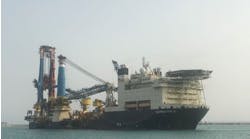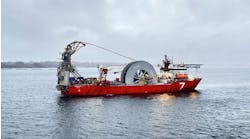Offshore staff
PORTOVAYA BAY, Russia -- Nord Stream’s twin gas pipeline system in the Baltic Sea is fully onstream, 30 months after construction started on the first line.
Russian, German, and French government ministers and officials officially inaugurated thesecond pipeline. Together the 1,224-km (760-mi) parallel lines will provide capacity to transport up to 55 bcm/yr (1.92 tcf/yr) of natural gas a year from Russia to the European Union for at least 50 years.
Line 1 began transporting supplies to Europe last November.
By starting the gas flow in the control center of the nearby Gazprom Compressor Station Portovaya, Russian gas can now be pumped without the need for interim re-compression along the entire route through the Baltic Sea and onwards into Europe’s gas transmission network.
The compressors generate pressures of up to 220 bar (3,191 psi) to take the gas through both pipelines to Lubmin on the German Baltic coast.
In his speech, Alexey Miller, chairman of the Gazprom Management Committee, revealed that the Nord Stream shareholders had examined preliminary results of feasibility studies for construction of third and fourth pipeline strings. Their conclusion was that construction was economically and technically feasible.
“By January 31,” Miller added, “it is planned to sign a memorandum on creating new gas transmission facilities across the Baltic Sea to Europe. One of the strings might be intended for delivering Russian gas to the United Kingdom. And we see interest in this project on the part of our British partners.”
10/9/2012


